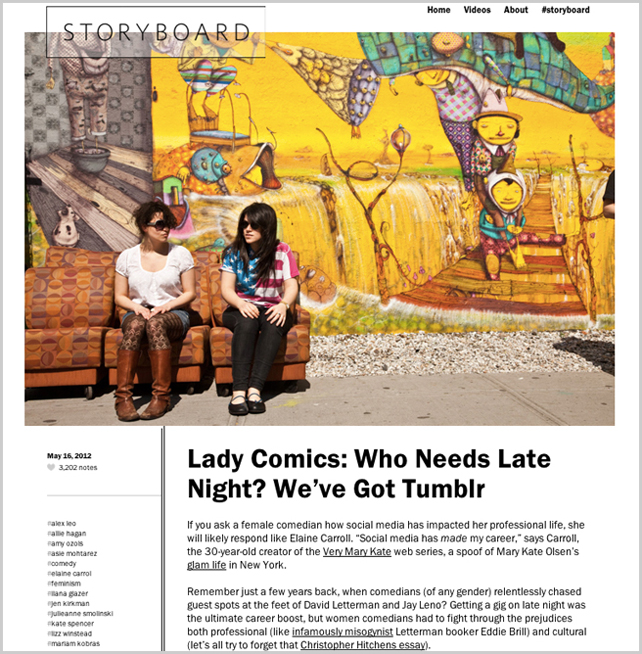What would you do if you were named the first-ever editor of one of the world's fastest-growing media companies and put in charge of a publishing platform with about 44 million users? Chris Mohney on taking Tumblr beyond "F*&% Yeah" memes.

Let's say you were handed the keys to a new, experimental department at one of the fastest-growing media companies on the planet. What would you do? (Keep in mind that panicking is not an option.) That’s the position in which Chris Mohney now finds himself. In February Mohney became Tumblr’s first-ever “editor-in-chief.” That sure sounds like an innovator’s dream job: no rulebook, a company culture that thrives on creativity, and a CEO in David Karp who, according to Mohney, wants to works with you, not against you.
"Tumblr’s revenue plan is to find partners who are interested in doing creative stuff on Tumblr."
 Mohney has worked as editor of Gawker and Gridskipper and oversaw Blackbook magazine and all of its associated guides and websites. But now he's facing a problem more familiar to a new startup than a blog or publication or an established publishing platform with roughly 44 million users that some reckon will surpass blogs in Google popularity soon enough. He has “an avalanche of choices," as he puts it. "When I first came in, the idea was to create this atmosphere of
creative encouragement, but how that would be accomplished was
completely undefined,” Mohney says.
Mohney has worked as editor of Gawker and Gridskipper and oversaw Blackbook magazine and all of its associated guides and websites. But now he's facing a problem more familiar to a new startup than a blog or publication or an established publishing platform with roughly 44 million users that some reckon will surpass blogs in Google popularity soon enough. He has “an avalanche of choices," as he puts it. "When I first came in, the idea was to create this atmosphere of
creative encouragement, but how that would be accomplished was
completely undefined,” Mohney says.
That changed quickly. Earlier this month, Mohney helped launch the first piece of a new editorial strategy called Storyboard, a page highlighting individuals and organizations using Tumblr in creative ways. "This is the first thing Tumblr has done that has a significant outward-facing goal," Mohney says, so setting an appropriate tone early on was crucial. The initial content includes a feature on the New York Times’ photo archive and its companion Tumblr. Elsewhere, you’ll find an interview with Dotan Negrin who uses Tumblr to document his piano-playing adventures across New York City. Storyboard even launched its first infographic last week charting the data behind Tumblr’s 103,227 "Fuck Yeah" blogs (proof that Tumblr still hasn’t sacrificed its playfulness in the name of “serious journalism.”)
While the role of his team is still very much a work in progress, one thing is abundantly clear when talking to Mohney: his respect for the Tumblr community. And in a media environment where users are increasingly suspicious about the motives of the people running their favorite web platforms, that user-first emphasis could be what gives Tumblr an edge over its competitors.
About This Series
Fast Company profiles the personalities behind the ideas that shake up business as usual. Discover more about these pioneers here.
But is it journalism or just PR? Or something else entirely? These are the kinds of questions currently facing community managers at newspapers and tech companies around the world. But while the promotional and marketing potential of Storyboard is obvious, Mohney says the big goal of these editorial projects is not only to introduce newcomers to Tumblr, but to make existing users more aware of each other and the work they’re doing. “We’re less interested in profiling people who are already well-known, and more in finding things that are new and interesting or maybe wildly popular within a small niche community. There are niches that may be insanely popular and have thousands or maybe even millions of readers but they don’t generally cross-pollinate with other groups. They exist kind of in parallel. One of the things we’re trying to do is try and break this barrier.”

While building stronger bonds between users is a philosophical win, will it lead to higher revenues? Mohney says making money, beyond Storyboard's marketing benefit, isn’t the goal of the editorial team, at least not yet. “As far as monetizing editorial stuff, it’s not about that.”
Nevertheless, if editorial projects like Storyboard act as the glue holding Tumblr's community together, particularly as the site expands, then who's to say it won't be a crucial component of Tumblr's revenue strategy down the road? After all, look at what happened to Flickr after Yahoo failed to maintain the site's community. But as far as how editorial fits in with Tumblr's immediate revenue goals, including Karp's recent reversal on bringing in advertisers, Mohney says there’d be little benefit in getting sponsors involved with his side of the operation at this time. "Tumblr’s revenue plan is to find partners who are interested in doing creative stuff on Tumblr as opposed to just bringing in banner ads. If (advertisers) are doing something great as part of their sponsorship program, they’ll get a lot more recognition out of that than from our editorial recognition."
Before the year is out, Mohney says he would love to create multiple Storyboard pages that curate content for specific topics like fashion or politics, not unlike a more traditional news site. But don’t expect Tumblr to become the next Huffington Post. "None of this will take the traditional aggregation approach. For us to do that at a smaller scale would be completely counterintuitive and not useful. But what we can do is bring our skill and professional experience to doing more elaborate stories about creators and why they’re doing it."
Follow David Holmes on Twitter, and Fast Company, too.